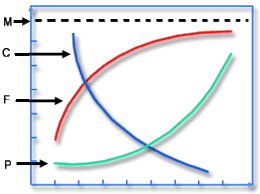The effect of heat transfer increases as the flow of coolant changes from laminar flow to turbulent flow.
For laminar flow, heat can be transferred only by means of heat conduction from layer to layer. However, in turbulent flow, the mass transfer in the radial direction enables the heat to be transferred by both conduction and convection. As a result, the efficiency increases dramatically.

Left: Laminar flow, Right: Turbulent flow
Since the increase of heat transfer will diminish as the coolant flow becomes turbulent, there is no need to increase the coolant flow rate when the Reynolds number exceeds 10,000. Otherwise, the small, marginal improvement in heat transfer will be offset by the higher pressure drop across the cooling channels, along with more pumping expense.
Once the flow becomes turbulent, a higher coolant flow rate brings diminishing returns in improving the heat flow rate or cooling time, while the pressure drop and pumping expenses are drastically increasing. This concept is shown below.

Flow rate
Where M= maximum heat flow rate, C= cooling time, F= heat flow rate, and P= pressure drop.
Restrictive flow plugs
Coolant will take the path of least resistance to flow. Use a restrictive flow plug in certain cooling channels to redirect the flow of coolant to other cooling channels that have a high heat load.